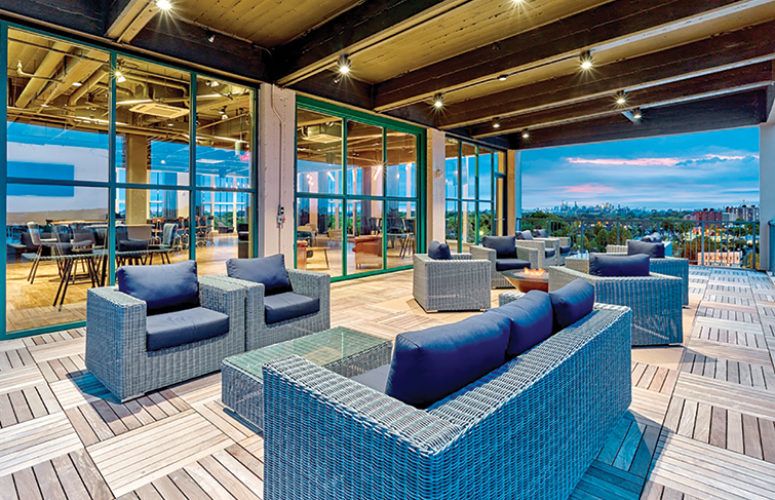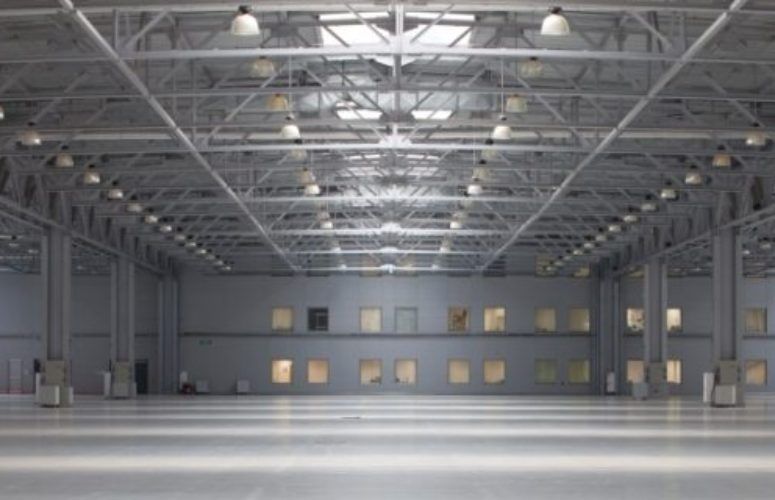
Commercial Real Estate Endeavors
A showcase of the state’s CRE projects and trends.
By Tim McEntyre, Contributing Writer On Jul 8, 2019To coin a phrase – ‘Are there any new developments?’”
The answer being emblazoned all across the Garden State is an emphatic, “Yes!” Major developments range from notable office/industrial projects to impressive mixed-use projects.
It is no secret to commercial real estate experts and investors that industrial distribution, particularly from the E-commerce sector, has been driving industrial demand nationwide, especially in our state. Current industrial projects in New Jersey have been nearly-exclusively geared toward distribution use. Of the 200+ buildings 50,000 square feet or greater that have been built or are under construction in New Jersey in the last five years, more than 90% have been developed as warehousing and distribution facilities. Demand for this new, largely Class A space has been at such a sustained high that these buildings are predominantly leased prior to or immediately after being delivered to market.
“It’s been an exciting time for industrial real estate. The momentum in demand for new distribution space has been encouraging builders to undertake spec projects and the market hasn’t disappointed them,” says Scott Mertz, president of NAI Mertz.
To that point, New Jersey’s industrial market suffers from a severe shortage of new product, resulting in skyrocketing asking rents. According to the “First-Quarter 2019 Industrial Market” report recently released by Transwestern Commercial Services (TCS), the nearly 6 million square feet of industrial space currently under construction in New Jersey’s core market is not enough to quench the demand, which TCS also concurs is being driven by the growing number of national retailers seeking a presence in the state.
Although there was more than 14 million square feet of industrial inventory under construction in New Jersey as recently as early 2018, a large block of the new space has already been leased. As a result, large tenants are committing to planned developments that have not yet begun construction.
As large-scale institutional developers tend to go after big projects and even bigger tenants, certain CRE firms (e.g., Commercial Realty Group (CRG) of Parsippany), also seek-out projects that can accommodate relatively small tenants. “Small business is the driver of American innovation and the American economy,” says Andy Billing, general manager of CRG. “We deliver highly-functional space for small businesses that want a little sizzle, and we really think we’ve done that especially well with our most recently completed adaptive-reuse projects,” he adds, referring to 7 Eastmans Rd. on the industrial playing field and the new 111 Littleton, a pioneering effort featuring Class A office space for smaller users. Both sites are in Parsippany.
It’s also important to point out that much of the leasing activity (also triggering new and adaptive reuse construction projects) in New Jersey is taking place in manufacturing buildings, which, year-over-year, experienced one million square feet of absorption and, as a direct outcome, a spike in rents exceeding 20%.
“New Jersey has added manufacturing jobs for five consecutive years, and consumer spending remains extremely strong, with the trend toward online shopping serving as the driving factor,” says Matthew Dolly, New Jersey research director at TCS. “Since this reality makes proximity to customers paramount, retailers that are not yet here continue to target New Jersey because of its access to the region’s densely populated, wealthy consumer base,” he adds.
On a larger scale of industrial development, Rockefeller Group, a prominent real estate developer, owner and operator, along with its joint venture partner PCCP, LLC, has just sold two of its recently completed distribution centers (totaling more than 1 million square feet) located in the Rockefeller Group Logistics Center to real estate firm DWS Group. This marks the first two sales at the logistics park, where Rockefeller Group is developing its five-building master-planned industrial park totaling more than 2 million square feet, sitting on a 228-acre site.
The first building, a 725,000-square-foot distribution center located at 300 Ridge Road, was fully leased during construction to Best Buy. The second building, located at 100 Ridge Road, is a 311,000-square-foot distribution center that is leased by two tenants respectively, Fujitsu General America Inc. (“Fujitsu General”) and Humanscale. Each tenant occupies approximately 155,000 square feet.
“The sale of these completed buildings at Rockefeller Group Logistics Center shows the high level of demand for Class A industrial property in New Jersey,” says Heath Abramsohn, Rockefeller group vice president and regional director for the New Jersey and Pennsylvania region.
“With current activity, we anticipate that this project will be fully leased and built out within 18 months,” says Jules Nissim, a Cushman & Wakefield brokerage specialist. “Its success is reflective of the shifting market fundamentals that are driving tenants to the I-287 market.” Submarket rents have soared 69 percent over the past five years and currently maintain a 0.7% vacancy rate, according to the Cushman & Wakefield research department team.
New Jersey’s development community has shifted to a substantial redevelopment posture. This trend couldn’t be more appropriately exemplified than by New Jersey’s largest commercial redevelopment project, Prism Capital Partners’ ON3 master-plan of the former Hoffmann-La Roche campus in Passaic and Essex counties.
This redevelopment represents New Jersey’s next generation lifestyle hub, as it continues to set a benchmark in “walking urbanism” for its world-class, mixed-use setting integrating second-to-none office space, R&D facilities, recreational, hospitality and wellness options thus creating a 24/7 environment. The site is ideally located on Route 3, between the Garden State Parkway and NJ Turnpike.
Prism has made several impressive announcements. First, its plan for the first of its ground-up construction projects at the 116-acre campus spanning Clifton and Nutley. The planned new development will add approximately 400,000 square feet of laboratory facilities, expanding the campus’ building footprint by approximately 35%.
Prism is also slated to build a four-story, 150,000-square-foot speculative laboratory building on site. “This state-of-the-art facility will be New Jersey’s first spec lab in recent history and answer the market’s sustained demand for modern R&D space,” notes Prism’s Edwin Cohen, principal partner. “We already have leased approximately 500,000 square feet of existing lab space with continued strong interest.”
Additionally, Quest Diagnostics will break ground imminently for a flagship laboratory on a 12-acre parcel. The 250,000-square-foot, owner-occupied lab will become the largest in Quest’s network of more than 22 laboratory facilities across the US, and will employ some 1,100 people.
Quest Diagnostics and future tenants of the spec lab building will join the growing hub of industry leaders in the life sciences at ON3. Some noted examples: the new Hackensack-Meridian School of Medicine at Seton Hall University opened its doors at 123 Metro Boulevard; Seton Hall University’s Graduate College of Nursing and School of Health and Medical Sciences are also located at 123 Metro Boulevard; and Hackensack Meridian is creating a National Institutes of Health-designated Clinical Research Center on site.
ON3 is attracting high-profile companies from a range of sectors. Most recently, the Ralph Lauren Corporation signed a full-building lease, and will move its New Jersey hub to 100 Metro Boulevard (supported by a $33-million Grow NJ grant).
Another announcement is a new Class A office complex at ON3. The planned development of two towers would add approximately 400,000 square feet of office space to the Clifton side of the 116-acre campus, which also spans Nutley Township.
“A multitude of New Jersey’s development companies were ‘reared’ in the world of office development and have now substantially shifted their focus and portfolios to (adaptive reuse) mixed-use product,” declares George Kimmerle, CEO of Kimmerle Group. Kimmerle Group’s expertise is also informed by research efforts at Rutgers University’s Bloustein School of Planning and Public Policy, which looks at redevelopment in several contexts from traditional urban/city sites to suburban downtowns that are now termed exurban clusters.
“Couple this with a change in generational preferences in housing, changes in mobility and other issues that are impacting our work, transportation and living habits, and all of this ultimately effects what gets built and in what form,” Kimmerle says.
While Kimmerle Group (Harding Twp.) has maintained a substantial presence in office design, it has simultaneously transitioned as a major player in the redevelopment sector, and creator of master plans for major sites in Newark and suburban New Jersey. The firm’s architectural entity (Kimmerle Newman Architects) is currently serving as architect of record for more than 15 million square feet of office space in New Jersey alone. At the same time, it is leading planning and design efforts for more than 3,000 units of (residential) housing on multiple sites, many with a mixed-use posture.
To that theme, The Hampshire Companies, along with Russo Development and Fourth Edition Inc., is moving ahead in its impressive endeavor to reinvent the former home of The Record newspaper, a nearly 20-acre site located at 150 River Street in Hackensack, into a luxury residential community featuring 650 residential units and 18,000 square feet of retail space. With demolition of the site’s existing buildings in its final stages, construction for the multiphase project is slated to begin as summer arrives.
According to James E. Hanson II, president & CEO of The Hampshire Companies, “We are proud to invest in the next chapter of Hackensack’s vibrant history as we look to create a transformative project that will support the continued success of the city’s resurgence.”
Another exciting “new development” is Paramount Assets’ pair of planned adaptive reuse projects, being positioned to breathe new life into two of Newark’s downtown commercial properties, following the purchases of 30-32 Clinton Street and 36-40 Clinton Street, respectively. The ideally-located buildings are within the City’s “Billion Dollar Triangle.” An area adorned by Newark Penn Station, the Prudential Center and NJPAC all nearby, and now to include these buildings poised to be the neighborhood’s newest mixed-use developments.
“The premier location of these properties made them very attractive to us,” says Richard Dunn, senior vice president of Paramount Assets. “30-32 Clinton Street and 36-40 Clinton Street meet all the necessary criteria for creating today’s successful adaptive reuse projects.”
The plethora of outstanding commercial projects dotting our landscape is literally endless and too long to document in its entirety. Following are some additional projects of note:
Denholtz Associates’ The Rail @ Red Bank Station – a redevelopment project that will transform a 1.25-acre site currently occupied by a 30,000-square-foot office building at 116-118 Chestnut Street, a vacant lot at 101-107 Oakland Street, and two closed restaurants into a transit-oriented mixed-use development in the heart of Red Bank.
The Hampshire Companies and joint venture partner Pinnacle Companies plan Montclair’s Lackawanna Plaza. The 216,772-square-foot mixed-use redevelopment will revitalize the once vibrant complex through the strategic development of a range of modern retail, office and residential spaces while preserving historical elements of the century-old station.
Finally, Prism Capital Partners’ formal construction completion of The Residences at Edison Lofts, a former crumbling, 400,000-square-foot factory that today serves as the centerpiece of Prism’s adaptive reuse of the 100-year-old factory built by Thomas Edison himself. Prism unveiled 21 penthouse homes consisting of 300 studio, one-, two-, and three-bedroom homes take advantage of original architectural features, incorporating 14- to 16-foot ceilings, and 8- and 10-foot replica replacement windows.
To access more business news, visit NJB News Now.
Related Articles:





